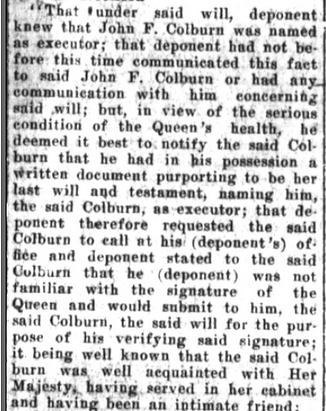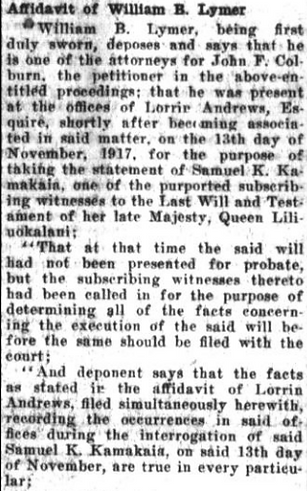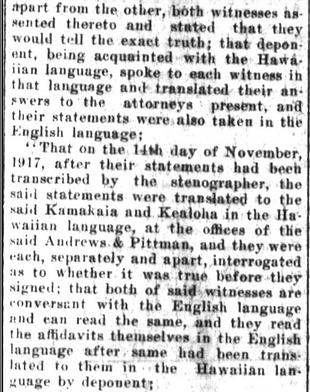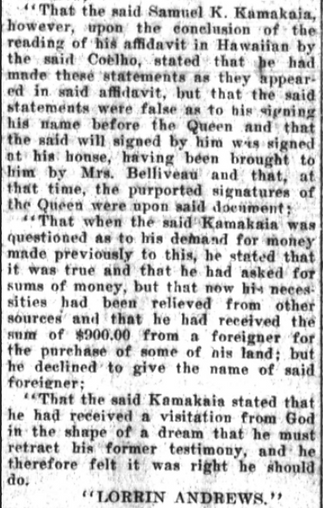
Princess Theresa Owana Kaʻōhelelani
was Framed on Forgery Charges
in Connection With The 1917
Last Will & Testament of Queen Liliʻuokalani
After Queen Lili`uokalani passed away on November 11, 1917 there were two documents of her majesty’s estate presented for probate:
The first document was a Trust Deed executed on December 2, 1909 that was already in litigation, filed by Delegate Kuhio, against the queens named Trustees on November 30, 1915. The lawsuit asked for an annulment of the 1909 Trust Deed that was a result of a conspiracy on the part of Col. Curtis P. Iaukea and John Aimoku Dominis. Another Trustee who drafted the queens Trust Deed was Mr. William O. Smith, he was also involved in the conspiracy to overthrow the kingdom. Col. Iaukea served under King Kalakaua and Queen Liliuokalani as commissioner of the crown lands. He later abandoned Queen Liliuokalani after the illegal overthrow and took the oath of loyalty to the Provisional Government, keeping his position of commissioner of the Crown Lands and William O. Smith was appointed Commissioner of the Crown Lands in 1893. (Newpaper article of Kuhio's complaint Page 1 Page 2)
Two months after the Trust Deed was filed, Queen Liliuokalani filed to revoke it because of the sudden arrogance of the trustees and decided she could not trust them. It was tragic to learn of the betrayal that the Right of Revocation had been deleted prior to the queen signing the Trust Deed. The three named Trustees, Iaukea, Dominis, and Smith, threatened to fight the queen with lengthy court battles, with no alternatives the queen was forced to leave the trust in their hands. On March 30, 1917, the court appointed Mr. Lorrin Andrews as guardian to Queen Liliʻuokalani to answer for her in Kuhioʻs law suit and to protect her interest from the trustees.
The other document filed was the Last Will and Testament of Queen Lili`uokalani, drafted confidentially in July, 1917 by her court appointed guardian, Mr. Lorrin Andrews, which was executed on August 29, 1917. The appointed Trustees of the 1909 Trust Deed along with Delegate Kuhio both objected to the 1917 Will, saying they would contest it. Trustee Col. Iaukea was the first to attack the will and stated that Queen Liliuokalani could not break the 1909 Trust Deed without their consent. Mr. Lorrin Andrews, attorney for the 1917 Will, questioned the merits and validity of the 1909 Trust Deed that gave absolute control of the queens entire personal estate to Col. Iaukea who was at that time under litigation by Delegate Kuhio.
The 1917 Will exhibited the signatures of two witnesses, James M. Kealoha and Samuel Kamakaia, who signed in the presence of the queen and Princess Theresa. The Will named Attorney John F. Colburn, guardian of the Kawananakoa minor children, as Executor. Mr. Lorrin Andrews, previously named guardian for the queen, consulted with his colleague Mr. Lymer and it was decided to bring the witnesses in to be interrogated as to the validity of the Will before filing it in Probate Court. On November 13, 1917 the two witnesses, James M. Kealoha and Samuel Kamakaia, were interrogated in separate rooms. Their sworn affidavits were given under oath, saying that they witnessed Queen Liliuokalani signing her Will. Both witnesses described everything in great detail and they were found to be telling the truth. Mr. Colburn was well acquainted with the queen and compared her signature of the 1917 Will to her signatures which he had in his possession and expressed in his expert opinion that the 1917 Will was indeed signed by Her Majesty.
Soon after, Kamakaia started making demands for money and was offered a bribe of $900.00 to change his affidavit. He then became corrupt, telling Princess Theresa that he wanted $5,000.00 right away and $10,000.00 more once the estate was settled. He said that if she would not guarantee it he would change his affidavit. Princess Theresa refused his demands upon which he confronted Kuhio, asking for $5,000.00 to change his affidavit, saying that he held the 1917 Will in the palm of his hands and could either release it or crush it as he pleased.
Word got to John Colburn of the bribery and blackmail attempts so on December 12, 1917 the two witnesses were called in to reaffirm their sworn affidavits. James Kealoha affirmed his affidavit was indeed true, but apparently Kamakaia had accepted the bribe and said his affidavit was false. Kamakaia admitted demanding money, saying he had received $900.00 from an unknown foreigner and wanted to repudiate his statement on his sworn affidavit. Kamakaia later denied receiving the $900.00, changed his story, said he lied, and that the queen did not sign the Will. He then said that Princess Theresa told him what to say in an exchange of a church and that God told him to tell the truth. He went on to change his story a few times, saying that he signed the Will at his house, then later said that he signed the Will at the home of Princess Theresa.
After changing his affidavit, John Colburn withdrew himself from the Will and Mr. Lorrin Andrews withdrew the application from probate. Upon fearing that Princess Theresa would file the Will herself, it was decided that the prosecution should seek for a conviction to prevent it from ever surfacing in probate.
The unknown foreigner who paid Kamakaia was never identified. Princess Theresa insisted it was her enemies framing her of forgery and creating evidence by way of bribes to repute the witnesses. Mr. William O. Smith (trustee named in the Trust Deed) and his attorney said they secured evidence to break down the 1917 Will and to make certain that Kamakaia would retract his sworn affidavit, but not Kealoha as of yet.
It came to pass that the Territorial Court prosecuted Princess Theresa for conspiracy of forgery and Kamakaia was to be the key witness for the prosecution. Princess Theresa pleaded not guilty along with Kealoha. In her defense, Princess Theresa claimed that it was a scheme from the other side and someone must be getting to Kamakaia, explicitly stating that she was being framed by her enemies. Princess Theresa said that the queen did not trust them and upon Prince Kuhios lawsuit against the trustees, the queen had asked to prepare another Will so she may leave something for Princess Theresa and her children because they are related by blood. Col. Iaukea agreed that the queen wanted to execute a new Will and had already started drafting one in July of 1917. Attorney for John Colburn, Mr. Lorrin Andrews (who drafted the 1917 will) said that the queen had secretly retained him several months before she died to aid in the drafting of her Will.
Princess Theresa stated that the queen signed the Will at her residence Washington Place with a borrowed pen from Representative Jimmy Jarret. She said the queen shook the fountain pen, spilling it on the Japanese robe she wore and returned the pen later. The pen went mysteriously missing as it was to be looked for as evidence of the signing.
During the prosecution, Princess Theresa was not allowed to appear in court to defend herself and she was never summoned to appear. Kealoha was also not allowed an attorney to represent him in the courtroom. Kamakaia turned states evidence for the prosecution and testified against the credibility of the Will as a forgery.
Once the elimination of the 1917 Will was secured it paved the way to settle the estate between Kuhio and the trustees. The U.S. Territorial Court of Hawaii found both Princess Theresa and James Kealoha to be guilty and sentenced them to three years in prison at hard labor. In June 1922 Princess Theresa’s sentence was commuted and she was released from prison. Princess Theresa continued to maintain her innocence, insisting that the Will was genuine and that she should not have been convicted and that she was framed on the forgery charges. Governor Farrington granted Princess Theresa a full pardon in 1922 and her civil rights were restored.
READ THE FULL AFFIDAVITS BELOW
_edited.png)
.png)
.png)
.png)
.png)
.png)
.png)
.png)
.png)
.png)
.png)
.png)
.png)
%20(1).png)
.png)
.png)
.png)
.png)
.png)
.png)
_edited.png)
_edited.png)


_edited.png)

_edited.png)